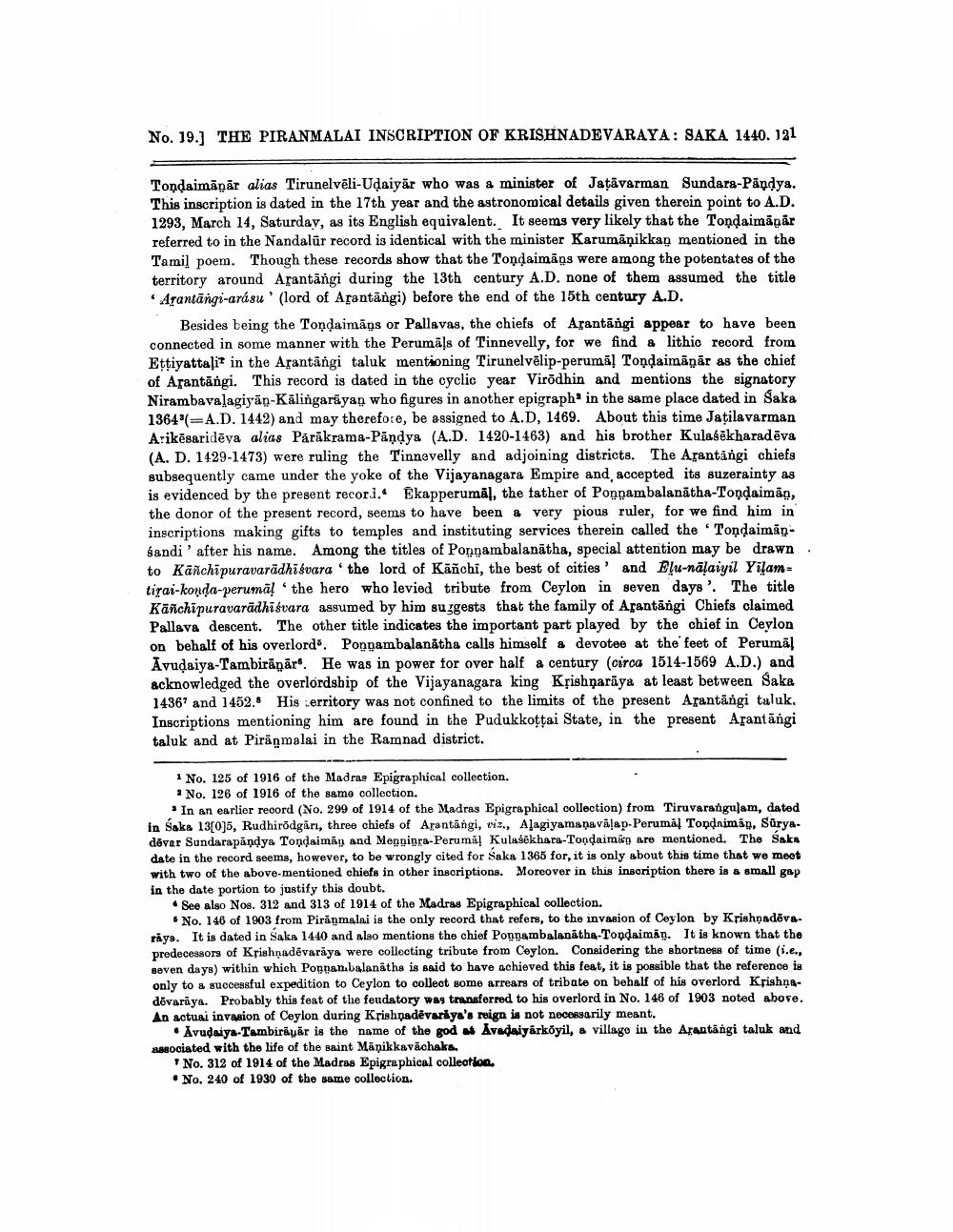________________
No. 19.) THE PIRANMALAI INSCRIPTION OF KRISHNADEVARAYA: SAKA 1440. 121
Tondaimāpār alias Tirunelvēli-Udaiyar who was a minister of Jațävarman Sundara-Pandya. This inscription is dated in the 17th year and the astronomical details given therein point to A.D. 1293, March 14, Saturday, as its English equivalent. It seems very likely that the Tondaimāpár referred to in the Nandalur record is identical with the minister Karumāņikkan mentioned in the Tamil poem. Though these records show that the Tondaimīgs were among the potentates of the territory around Arantängi during the 13th century A.D. none of them assumed the title Arantāngi-arásu' (lord of Asantāngi) before the end of the 15th century A.D.
Besides being the Tondaimãns or Pallavas, the chiefs of Arantangi appear to have been connected in some manner with the Perumāļs of Tinnevelly, for we find a lithic record from Ettiyattalit in the Arantängi taluk mentioning Tirunelvēlip-perumal Tondaimánär as the chief of Asantāngi. This record is dated in the cyclic year Virõdhin and mentions the signatory Nirambavalagiyan-Kälingarāyan who figures in another epigraph in the same place dated in Saka 1364'(=A.D. 1442) and may therefore, be assigned to A.D, 1469. About this time Jatilavarman A:ikēsaridēva alias Pårākrama-Pandya (A.D. 1420-1463) and his brother Kulasēkharadēva (A. D. 1429-1473) were ruling the Tinnevelly and adjoining districts. The Arantangi chiefs subsequently came under the yoke of the Vijayanagara Empire and accepted its suzerainty as is evidenced by the present record. Ekapperuma], the father of Ponnambalanátha-Tondaimão, the donor of the present record, seems to have been & very pious ruler, for we find him in inscriptions making gifts to temples and instituting services therein called the Tondaimán. sandi' after his name. Among the titles of Ponnambalanātha, special attention may be drawn to Kanchipuravarādhisvara 'the lord of Kāñchi, the best of cities' and Blu-nālaiyil Yilantirai-konda-perumä! 'the hero who levied tribute from Ceylon in seven days'. The title Kanchipuravaradhisvara assumed by him suggests that the family of Arantangi Chiefs claimed Pallava descent. The other title indicates the important part played by the chief in Ceylon on behalf of his overlord. Ponnambalanātha calls himself a devotee at the feet of Perumā! Avudaiya-Tambiränar. He was in power for over half a century (circa 1514-1569 A.D.) and acknowledged the overlordsbip of the Vijayanagara king Krishnariya at least between Saka 14367 and 1452. His territory was not confined to the limits of the present Arantängi taluk, Inscriptions mentioning him are found in the Pudukkottai State, in the present Arantängi taluk and at Piräşmalai in the Ramnad district.
1 No. 125 of 1916 of the Madras Epigraphical collection. * No. 126 of 1916 of the samo collection.
In an earlier record (No. 299 of 1914 of the Madras Epigraphical collection) from Tiruvarangulam, dated in Śska 13[0]5, Rudhirõdgar, three chiefs of Arantāngi, viz., Alagiyamanavālap-Perumal Topdniman, Süryadóvar Sundarapandya Tondaimky and Moppinra-Peruma! Kulasēkhara-Topdaimk are mentioned. The Saks date in the record seems, however, to be wrongly cited for Saka 1365 for, it is only about this time that we meet with two of the above-mentioned chiefs in other inscriptions. Moreover in this inscription there is a small gap in the date portion to justify this doubt.
See also Nos. 312 and 313 of 1914 of the Madras Epigraphical collection.
* No. 148 of 1903 from Pirāņmalai is the only record that refers to the invasion of Ceylon by Krishnadevaråyo. It is dated in Saka 1440 and also mentions the chief Ponnambalanatha Tondaiman. It is known that the predecessors of Krishnadevaraya were collecting tribute from Ceylon. Considering the shortness of time (i.e., seven days) within which Ponnan.balanātha is said to have achieved this feat, it is possible that the reference is only to a successful expedition to Ceylon to collect some arrears of tribate on behalf of his overlord Krishngdövariya. Probably this feat of the feudatory was transferred to his overlord in No. 146 of 1903 noted above. An actuai invasion of Ceylon during Krishpadēvariya's reign is not necessarily meant.
• Avudaiya-Tambirävär is the name of the god at Avadaiyarköyil, a villago in the Arantängi taluk and sociated with the life of the saint Manikkavachaka.
No. 312 of 1914 of the Madras Epigraphical collection • No. 240 of 1930 of the same collection.




